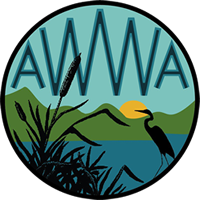VRAP Team AWWA got off to a stellar start on July 9th monitoring four sites on the Salmon Falls and Branch rivers. VRAP is the NHDES Volunteer River Assessment Program. The AWWA team of Jeanne Achille, Kari Lygren, Diana Spahn and Glenn and Stephanie Thornton spent the morning with VRAP intern Tanya Dyson, and AWWA’s Linda Schier, learning the ins and outs of the monitoring protocols and equipment. The team is collecting data to develop a baseline portrait of the water quality in the upper Salmon Falls River as part of the Salmon Falls Watershed Collaborative’s effort to protect the river:
“The Salmon Falls River is fed by an ecologically diverse land area shared by the states of Maine and New Hampshire, and drains into the Great Bay estuary, a coastal ecosystem of national importance. Approximately 47,000 people (not including well users), including the population centers of Berwick, Maine and Somersworth, NH, currently rely on the Salmon Falls watershed to provide clean drinking water. The watershed is potentially threatened by increases in polluted runoff resulting from rapid population growth and conversion of forested land to developed areas.”
Twice a month throughout the summer, VRAP Team AWWA will be taking readings on Dissolved Oxygen, Conductivity, Temperature, pH, and Turbidity. Regular collection of water quality data allows for early detection of water quality changes allowing DES to trace potential problems to their source. The team of novice monitors started the day with a bit of trepidation but by the end of it they were calibrating, measuring, counting, and recording like pros. The teamwork was impressive and they have committed to their sampling dates for the rest of the season. Way to go Team AWWA!
According to the VRAP website – “During the summer months, VRAP receives water quality data from trained volunteers. The data are reviewed for quality assurance, and are entered into the environmental monitoring database (EMD) at DES. During the off-season, VRAP interprets the data and compiles the results into an annual report for each river. VRAP volunteers can use the data as a means of understanding the details of water quality, as well as guide future sampling efforts. DES can use the data for making surface water quality assessments, provided that the data met certain quality assurance/quality control guidelines.”
If you are interested in learning more about either the river sampling or lake sampling contact AWWA. The lake monitors on each lake are always looking for more volunteers and there are many more river sites that we’d like to be monitoring. There’s a job for you if you are a veteran scientist or have never turned on an instrument. We’d love to hear from you.


